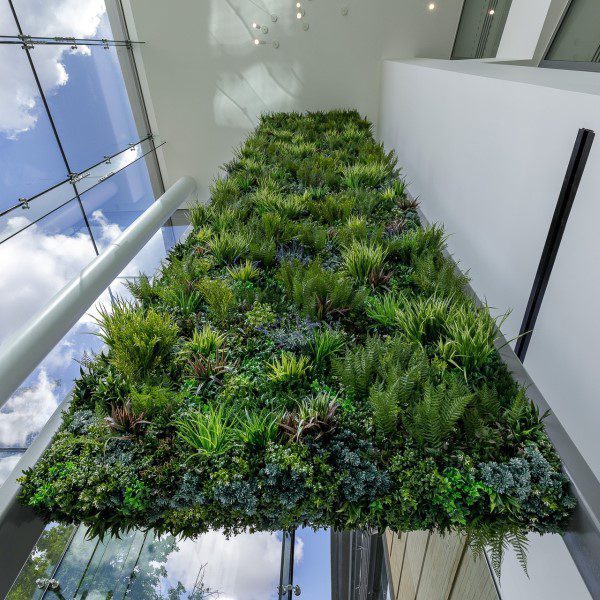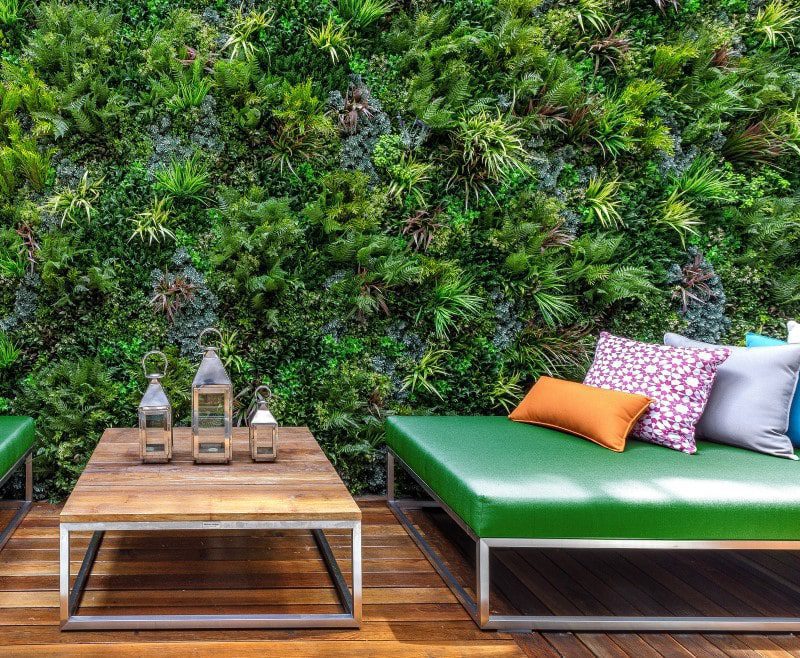In the ever-evolving landscape of interior design, a captivating trend has taken root: artificial green walls. These innovative installations have quickly become a focal point for architects, designers, and businesses looking to transform their spaces into vibrant, natural havens. The allure of these botanical masterpieces lies in their ability to seamlessly blend nature’s tranquillity with modern urbanity, all while offering a sustainable and low-maintenance solution.
Artificial green walls, also known as vertical gardens or living walls, represent a paradigm shift in how we perceive interior aesthetics. Gone are the days when a room’s beauty relied solely on paintings or traditional decorations. Today, these walls of lush foliage redefine elegance, breathing life into otherwise sterile environments. The vibrant shades of green provide a harmonious backdrop that complements various design styles, from sleek minimalism to cosy rustic charm, and with the addition of ultra-realistic flowers, you can create a look to suit an interior.
But what sets artificial green walls apart? Unlike their living counterparts, these installations require no watering, sunlight, or soil. This marks a significant leap in sustainable design practices, conserving water resources and eliminating the need for continuous maintenance. The meticulously crafted synthetic plants capture the essence of real flora, down to the finest details of texture and colour variations. This level of realism ensures that the walls remain a captivating feature, delighting visitors and occupants alike.
The applications of artificial green walls are as diverse as the designs themselves. In commercial spaces, they create an inviting atmosphere that entices customers and encourages longer stays. Hotels and restaurants, for instance, can evoke a sense of outdoor dining with these walls, enhancing the overall dining experience. Corporate offices, on the other hand, benefit from a boost in employee well-being, ultimately leading to enhanced productivity.
Revitalizing Workspaces: Artificial Green Walls and the Health Benefits for Office Staff
In the modern era of work, where employee well-being and productivity are paramount, offices are undergoing a transformative change by integrating artificial green walls into their design. Beyond their aesthetic appeal, these botanical installations are proving to be a powerful tool in enhancing the work environment and fostering the health and happiness of office staff.

Biophilic Design in the Office
Biophilic design, a concept rooted in our innate connection to nature, has gained considerable attention for its positive impact on various facets of well-being. Artificial green walls, embodying the principles of biophilic design, offer a practical means of bringing nature into the office setting. The calming effect of lush greenery fosters a more soothing and relaxing atmosphere, countering the stressors often associated with the demands of the workplace.
Improved Productivity
The presence of these artificial green walls positively influences cognitive function and productivity. Studies have shown that exposure to nature-inspired elements, such as plants, can lead to heightened creativity, improved concentration, and better problem-solving skills. This translates to a more motivated and efficient workforce, which is a win-win for both employees and employers.
Stress Reduction and Well-Being
The fast-paced nature of many office environments can contribute to heightened stress levels among employees. Artificial green walls offer a natural antidote to this issue. The soothing visuals of verdant foliage create a calming effect, reducing feelings of stress and anxiety. The mere act of gazing at these installations can induce a sense of tranquillity, providing brief respites that recharge employees during busy workdays.
In addition, the presence of greenery has been linked to improved mental health outcomes. It can help alleviate symptoms of burnout, boost overall mood, and enhance feelings of job satisfaction. As companies increasingly prioritize employee well-being, incorporating elements that support mental health, like artificial green walls, becomes an essential strategy.
Promoting Social Interaction
Beyond their impact on individuals, artificial green walls can also shape the dynamics of office culture. These installations often serve as focal points, encouraging employees to gather, interact, and collaborate in rejuvenating environments. Informal discussions, brainstorming sessions, and team meetings take on a refreshing dimension when surrounded by the soothing aesthetics of these green walls.
As the corporate world embraces the importance of employee well-being and productivity, artificial green walls have emerged as an ingenious solution. With their ability to infuse offices with the serenity of nature, and promote mental and physical health, these installations are revitalising workspaces in unprecedented ways. By transforming the office environment into a place of comfort and inspiration, artificial green walls are shaping the future of office design and ushering in an era of holistic well-being for staff.
Retail Stores and Artificial Green Walls
Retail stores have also harnessed the power of artificial green walls to showcase their products in an enchanting setting. By blending the vibrancy of nature with the allure of shopping, businesses create an immersive environment that engages customers on multiple sensory levels. Additionally, the visual impact of these walls serves as a memorable backdrop for social media content, further extending the brand’s reach.
The rise of artificial green walls has not gone unnoticed by the design community. Renowned architects and interior designers have seamlessly integrated these installations into their projects, showcasing their adaptability and artistic potential. From luxury residences to cutting-edge commercial spaces, the presence of these walls elevates the overall aesthetic and adds a touch of sophistication.
Hotels, Hospitality Businesses, and Airports Embrace the Verdant Revolution with Artificial Green Walls
Guest experiences and first impressions matter more than ever, and the hospitality industry has found a captivating solution in the form of artificial green walls. Hotels, luxury resorts, boutique inns, and even airports are recognizing the transformative power of these botanical installations, using them to create enchanting spaces that captivate visitors and offer a unique blend of nature and sophistication.
Hotels: Where Luxury Meets Nature
For hotels, the incorporation of artificial green walls goes beyond mere aesthetics; it’s about curating an ambience that resonates with guests on a deep level. From opulent lobbies to serene lounges, these vertical gardens elevate the overall atmosphere, immersing visitors in a world of lush greenery that feels like a natural escape from the urban hustle.
In the realm of hospitality, the utilization of artificial green walls is strategic. Hotels often face the challenge of maximizing limited outdoor space, especially in urban settings. These installations offer a remedy by allowing hotels to bring the outdoors indoors, blurring the boundaries between interior and exterior environments. Rooftop bars and poolside lounges are transformed into lush sanctuaries, creating memorable settings that encourage relaxation and socialization.

Enhancing Airport Experiences
Airports, known for their bustling and sometimes sterile environments, are also joining the movement towards incorporating nature-inspired design. Artificial green walls bring a sense of tranquillity and a touch of biophilic comfort to these spaces. Passengers waiting for flights are greeted by vibrant walls that not only enhance the aesthetics but also contribute to their well-being. Studies have shown that exposure to greenery, even in synthetic form, can reduce stress levels and improve overall mood—factors that are of paramount importance in bustling airport terminals.
Hospitality Businesses: Crafting Unique Experiences
Beyond hotels and airports, the hospitality industry at large is tapping into the allure of artificial green walls to craft unforgettable guest experiences. Restaurants, cafes, and event venues are utilizing these installations to enhance the ambience and set themselves apart in a competitive market. From cozy corners adorned with lush greenery to statement walls that serve as conversation starters, these businesses are embracing the trend to create memorable, Instagram-worthy settings.
In the age of social media, the visual appeal of these walls cannot be overstated. Guests are drawn to share their experiences on platforms like Instagram, inadvertently becoming brand ambassadors and expanding the establishment’s reach. In this way, artificial green walls have become a strategic marketing tool, leveraging the power of aesthetic appeal and user-generated content.
Artificial green walls have transcended their initial role as design elements and have become vital components in transforming hospitality spaces. From welcoming hotel guests with a soothing embrace of nature to offering travellers respite in the midst of busy airport terminals, these installations enrich the overall experience and contribute to a sense of well-being. As the hospitality industry continues to evolve, it’s evident that the verdant revolution of artificial green walls is more than just a trend—it’s a strategic investment in creating spaces that resonate with visitors on a profound level.

Sustainable Design Solutions
As the demand for sustainable design solutions continues to grow, artificial green walls stand at the forefront of innovation. Their eco-friendly nature, coupled with the ability to transform any space into a breathtaking oasis, positions them as an indispensable tool for modern designers. By eliminating the constraints of traditional gardening and embracing the possibilities of synthetic realism, these walls herald a new era in interior design—one where nature and technology coalesce to redefine beauty and functionality.
In the realm of urban planning, artificial green walls hold promise as well. As cities expand and green spaces become scarcer, these installations offer a practical solution to bring nature back into the concrete jungle. Public areas and transportation hubs, and even rooftops can be adorned with these vertical gardens, providing a refreshing respite for residents and visitors alike. By embracing the concept of biophilic design, which seeks to reconnect humans with the natural world, cities can enhance their livability and foster a sense of community.
Technological advancements have played a pivotal role in perfecting the art of crafting artificial green walls. The incorporation of advanced materials and manufacturing techniques ensures the longevity and durability of these installations. UV-resistant coatings safeguard against fading, while innovative attachment systems offer seamless integration with existing structures. As a result, the possibilities for customisation are virtually limitless, allowing designers to tailor their creations to suit any space and aesthetic.
Artificial green walls are not only aesthetically pleasing but also contribute to environmental sustainability. With reduced water consumption and no need for harmful pesticides or fertilizers, they embody the principles of responsible design. This aligns with the global movement towards sustainable living and echoes the growing awareness of our impact on the planet.
The ascent of artificial green walls has ushered in a new era of interior design, marked by innovation, sustainability, and creativity. These botanical installations exemplify the marriage of nature and technology, crafting visually captivating spaces while minimizing environmental footprints. Their versatility spans from commercial establishments to urban landscapes, providing a welcome touch of greenery and respite from the hectic pace of modern life.
As architects, designers, and businesses continue to explore the potential of artificial green walls, it’s clear that this trend is here to stay. By harmonizing the allure of nature with the practicality of synthetic design, these installations have transcended mere aesthetics and become an integral part of contemporary interior and urban design. With a nod to sustainability and a vision for a greener future, artificial green walls have earned their place as a transformative force in shaping the spaces we inhabit.








